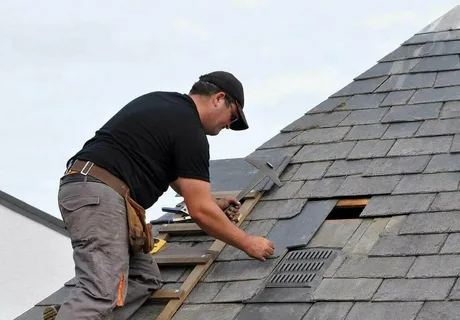Roof Replacement: When and Why You Need It

Your roof is your home’s first line of defense against the elements. Over time, wear and tear from harsh weather, aging, and unexpected damage can compromise its integrity. While minor repairs can fix some issues, there comes a time when a full roof replacement is the best solution. At Mike’s Roofing LLC, we understand that replacing your roof is a big investment, and we’re here to help you make the right decision.
Signs That It’s Time for a Roof Replacement
Not sure if you need a new roof? Here are some key signs that indicate it’s time to consider a roof replacement:
1. Your Roof Is Over 20 Years Old
Most roofs have a lifespan of 20–30 years, depending on the materials used. If your roof is approaching or exceeding this age, it’s wise to start planning for a replacement before leaks and other issues arise.
2. Frequent Repairs
If you find yourself constantly fixing leaks, replacing shingles, or dealing with water damage, a full replacement might be more cost-effective than ongoing repairs.
3. Missing or Damaged Shingles
Shingles protect your home from moisture and structural damage. If they are cracked, curling, or missing, your roof is vulnerable to leaks and further deterioration.
4. Water Damage and Leaks
Stains on your ceiling, mold growth, or water spots in the attic indicate a failing roof. Ignoring leaks can lead to serious structural damage over time.
5. Sagging Roof
A sagging roof is a serious red flag. It may indicate underlying structural damage or trapped moisture, both of which require immediate attention.
Benefits of Roof Replacement
Replacing your roof is a major investment, but it offers several long-term benefits:
Increased Property Value – A new roof enhances your home’s curb appeal and resale value.
Improved Energy Efficiency – Modern roofing materials provide better insulation, reducing heating and cooling costs.
Enhanced Safety – A sturdy roof protects your home and family from leaks, mold, and structural damage.
Lower Maintenance Costs – A new roof means fewer repairs and maintenance expenses in the long run.
Better Weather Protection – Newer materials offer superior resistance to wind, rain, and extreme temperatures.
The Roof Replacement Process
Replacing a roof may seem overwhelming, but knowing what to expect can make the process smoother. Here’s what typically happens:
1. Inspection and Assessment
A professional roofer will inspect your roof to determine if a replacement is necessary. They will check for leaks, structural damage, and wear.
2. Choosing the Right Materials
You’ll need to select the best roofing material for your home. Options include asphalt shingles, metal, tile, and more, each with unique benefits.
3. Preparing for Installation
The old roofing material is removed, and any underlying issues, like rotten decking, are addressed.
4. Installing the New Roof
The new roofing materials are installed with proper insulation, flashing, and sealing to ensure durability and weather resistance.
5. Final Inspection and Cleanup
After installation, a final inspection is done to ensure everything is properly installed. The job site is cleaned up, leaving you with a brand-new roof.
Choosing the Right Roofing Contractor
Selecting a reliable roofing contractor is crucial for a successful roof replacement. Here’s what to look for:
Licensed and Insured – Ensures protection against liabilities and guarantees professionalism.
Experience and Reputation – Look for reviews, testimonials, and past project examples.
Transparent Pricing – Get a detailed quote before starting the project.
Warranty Coverage – A good contractor will offer warranties on materials and workmanship.
Clear Communication – Choose a roofer who answers your questions and keeps you informed throughout the process.
Conclusion
A roof replacement is a significant investment that enhances your home’s safety, efficiency, and value. While it may seem daunting, working with an experienced roofing contractor ensures a smooth and stress-free process. If your roof is showing signs of age or damage, don’t wait until it becomes a bigger problem. Investing in a new roof now can save you money and headaches in the future.
FAQs1. How long does a roof replacement take?
Most roof replacements take 1–3 days, depending on the size and complexity of the project.
2. What is the best roofing material for my home?
It depends on your budget, climate, and aesthetic preference. Asphalt shingles are the most common, while metal and tile offer greater durability.
3. Will my homeowner's insurance cover roof replacement?
Insurance may cover roof replacement if the damage is due to storms or unexpected events, but not normal wear and tear.
4. Can I stay in my home during a roof replacement?
Yes, but expect noise and some disruption. If you work from home or have pets sensitive to noise, consider alternative arrangements.
5. How can I maintain my new roof?
Regular inspections, cleaning gutters, and addressing minor repairs promptly can extend the life of your new roof.
- Industry
- Art
- Causes
- Crafts
- Dance
- Drinks
- Film
- Fitness
- Food
- Games
- Gardening
- Health
- Home
- Literature
- Music
- Networking
- Other
- Party
- Religion
- Shopping
- Sports
- Theater
- Wellness
- News



